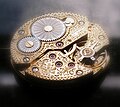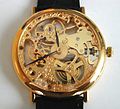Work plate (clock)
In small watches, a work plate or plate (also known as platina ) is the thin and flat part of a movement on which the components such as wheels , drives , bridges , cocks , barrels , bearings and shafts are attached. A work plate consists of a round blank in which holes and blind holes are milled. The spring mechanism , the gear mechanism , the pointer mechanism , the gear regulator and possibly also cadratures are mounted on a work plate (characterized according to assembly groups) .
The dial side of the work plate is called the underside and the other side is called the top . Work plates and their bridges are occasionally given additional designations such as caliber 3/4 work plate and 3/4 bridge , which refers to the length of the bridge relative to the diameter of the work plate.
In the case of a skeleton clock , the work plate is subsequently perforated, while in a minimal, figurative work plate, mechanically unnecessary parts are left out from the design.
photos
assembled and finished clockwork
literature
- Otto Böckle, Wilhelm Brauns: Textbook for the watchmaking trade. Work skills and materials. 8-10 Edition. Wilhelm Knapp, Halle (Saale) 1951 (reprint, edited by Michael Stern. Heel, Königswinter 2010, ISBN 978-3-86852-288-4 ).
- Hermann Brinkmann: Introduction to watchmaking (= The watchmaking school. Volume 2). 10th unchanged edition. Wilhelm Knapp, Düsseldorf 2005, ISBN 3-87420-010-8 .
- George Daniels : Watchmaking. Updated 2011 edition. Philip Wilson Publishers, London 2011, ISBN 978-0-85667-704-5 .
Individual evidence
- ↑ Georges-Albert Berner: Illustrated specialist dictionary of watchmaking. Keyword work plate. Retrieved January 26, 2012.





